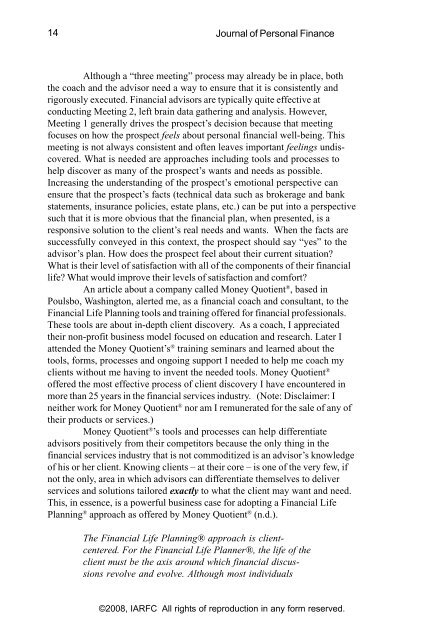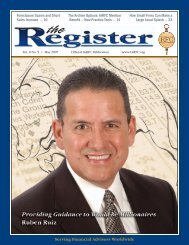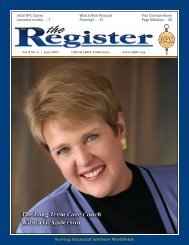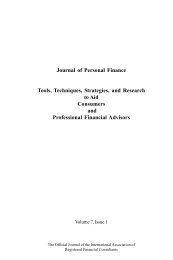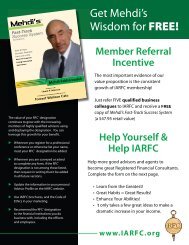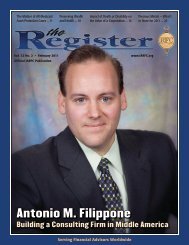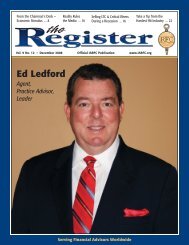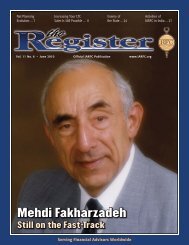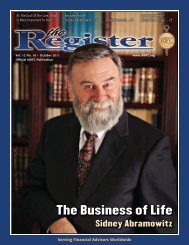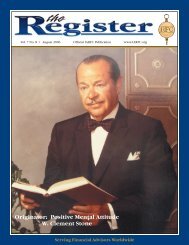3433-vol. 6 issue 2-3.pmd - iarfc
3433-vol. 6 issue 2-3.pmd - iarfc
3433-vol. 6 issue 2-3.pmd - iarfc
Create successful ePaper yourself
Turn your PDF publications into a flip-book with our unique Google optimized e-Paper software.
14<br />
Journal of Personal Finance<br />
Although a “three meeting” process may already be in place, both<br />
the coach and the advisor need a way to ensure that it is consistently and<br />
rigorously executed. Financial advisors are typically quite effective at<br />
conducting Meeting 2, left brain data gathering and analysis. However,<br />
Meeting 1 generally drives the prospect’s decision because that meeting<br />
focuses on how the prospect feels about personal financial well-being. This<br />
meeting is not always consistent and often leaves important feelings undiscovered.<br />
What is needed are approaches including tools and processes to<br />
help discover as many of the prospect’s wants and needs as possible.<br />
Increasing the understanding of the prospect’s emotional perspective can<br />
ensure that the prospect’s facts (technical data such as brokerage and bank<br />
statements, insurance policies, estate plans, etc.) can be put into a perspective<br />
such that it is more obvious that the financial plan, when presented, is a<br />
responsive solution to the client’s real needs and wants. When the facts are<br />
successfully conveyed in this context, the prospect should say “yes” to the<br />
advisor’s plan. How does the prospect feel about their current situation?<br />
What is their level of satisfaction with all of the components of their financial<br />
life? What would improve their levels of satisfaction and comfort?<br />
An article about a company called Money Quotient ® , based in<br />
Poulsbo, Washington, alerted me, as a financial coach and consultant, to the<br />
Financial Life Planning tools and training offered for financial professionals.<br />
These tools are about in-depth client discovery. As a coach, I appreciated<br />
their non-profit business model focused on education and research. Later I<br />
attended the Money Quotient’s ® training seminars and learned about the<br />
tools, forms, processes and ongoing support I needed to help me coach my<br />
clients without me having to invent the needed tools. Money Quotient ®<br />
offered the most effective process of client discovery I have encountered in<br />
more than 25 years in the financial services industry. (Note: Disclaimer: I<br />
neither work for Money Quotient ® nor am I remunerated for the sale of any of<br />
their products or services.)<br />
Money Quotient ® ’s tools and processes can help differentiate<br />
advisors positively from their competitors because the only thing in the<br />
financial services industry that is not commoditized is an advisor’s knowledge<br />
of his or her client. Knowing clients – at their core – is one of the very few, if<br />
not the only, area in which advisors can differentiate themselves to deliver<br />
services and solutions tailored exactly to what the client may want and need.<br />
This, in essence, is a powerful business case for adopting a Financial Life<br />
Planning ® approach as offered by Money Quotient ® (n.d.).<br />
The Financial Life Planning® approach is clientcentered.<br />
For the Financial Life Planner®, the life of the<br />
client must be the axis around which financial discussions<br />
re<strong>vol</strong>ve and e<strong>vol</strong>ve. Although most individuals<br />
©2008, IARFC All rights of reproduction in any form reserved.


